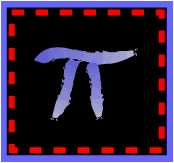
There are two ways (at the very least) to see beauty in mathematics and physics. One way is in its meaning (or substance--intellectual beauty) and the other is aesthetics, in other words, in the form.
Intellectual Beauty and Aesthetic Beauty Both at Once?
The ![]() I have drawn at the top of this page is beautiful to me for many reasons. I know it was discovered by the Greeks many millenia ago, and that its function in geometry is amazing. For any circle, huge or tiny, the ratio of circumference to diameter is always the same number; it is equal to
I have drawn at the top of this page is beautiful to me for many reasons. I know it was discovered by the Greeks many millenia ago, and that its function in geometry is amazing. For any circle, huge or tiny, the ratio of circumference to diameter is always the same number; it is equal to ![]() , without exception. I also find beauty, if not outright awe, in knowing that
, without exception. I also find beauty, if not outright awe, in knowing that ![]() is an unusual number, having an infinite number of decimal points (of which we only know 20.1 billion, so far) but no repeating pattern.
is an unusual number, having an infinite number of decimal points (of which we only know 20.1 billion, so far) but no repeating pattern.
Mathematicians call ![]() a "transcendental" number, that is, it cannot be expressed as the solution to an algebraic equation (like, x2 = 2) and its decimal digits repeat without pattern and go forever. And
a "transcendental" number, that is, it cannot be expressed as the solution to an algebraic equation (like, x2 = 2) and its decimal digits repeat without pattern and go forever. And ![]() comes up in some very surprising places in mathematics! For example, the area under a bell curve is the square root of
comes up in some very surprising places in mathematics! For example, the area under a bell curve is the square root of ![]() ! The strength of the electromagnetic force (electricity) is also a multiple of
! The strength of the electromagnetic force (electricity) is also a multiple of ![]() . And
. And ![]() is related to another transcendental number, e, in a spectacularly surprizing way! And that's just for starters. I find the intellectual mystery and the relationships of these numbers to be spiritual and beautiful.
is related to another transcendental number, e, in a spectacularly surprizing way! And that's just for starters. I find the intellectual mystery and the relationships of these numbers to be spiritual and beautiful.
How does aesthetics fit in here? Carl Sagan, an astronomer famous for his public talks, married an artist. He told a story once which struck me profoundly, because the idea is what I have always tried to get across to my students. He and his wife were watching a particularly beautiful sunset with blues, purples, oranges and red streaked across the sky. His wife gasped and uttered some words about how spectacular it was. Carl then started to explain how the sunset worked in order to make the beautiful display in the sky. His wife turned to him and said that he had just ruined it for her with the cold, hardened view of science. He was stupefied! He saw the physics of the sunset as being extraordinarily lovely and tried to explain to her that one kind of beauty (aesthetics) does not preclude another kind (intellectual). In fact, for him (and for me) they enhance each other. For example, looking at the stars on a dark, moonless night, I see a gorgeous starry sky. And once my eyes become adapted to low light levels, I start to see color in the stars: some are yellow, blue, white or red, each star a dazzling jewel. But my awe and sense of beauty for this sight owes as much to understanding what I'm looking at. Since the near-by stars are tens to hundreds of light-years away, I know that their light coming into my eyes left the stars tens to hundreds of years ago, and we have no way of knowing what those stars are like now. And I also know that their color is due to their temperature--cold stars are red and hot stars are blue. Just by looking at them with my naked eyes, I know somehting rather personal about those magnificent jewels so far away. That knowledge enhances the feeling of beauty for me.
And so it is with mathematics.
Here are some discussion questions you might think about ==> ?
An aspect that bridges intellectual appreciation with the beauty of form is the symbolism of an equation. An equation can be like a poem--succint, elegant, packed with layers of meaning. Let me show you what I mean in the two sections below....
| Aesthetics I -- One Picture is Worth a Thousand Words..... | |
| Aesthetics II -- Mathematical Art |
